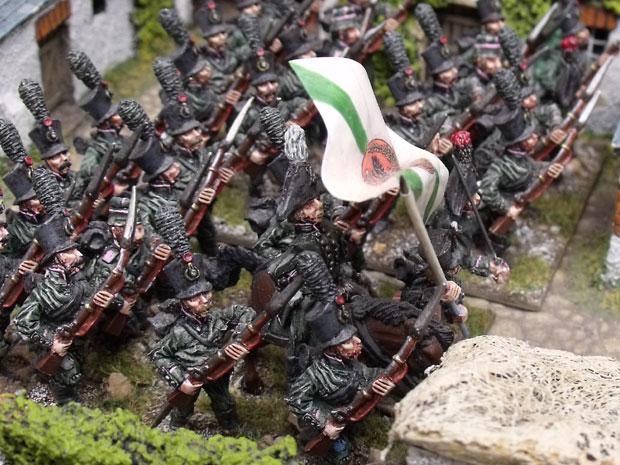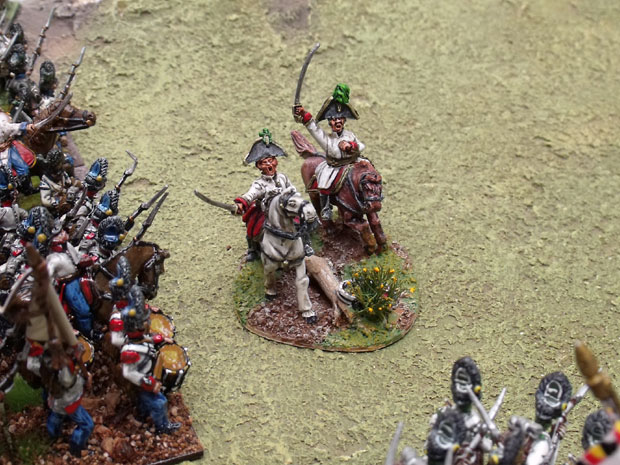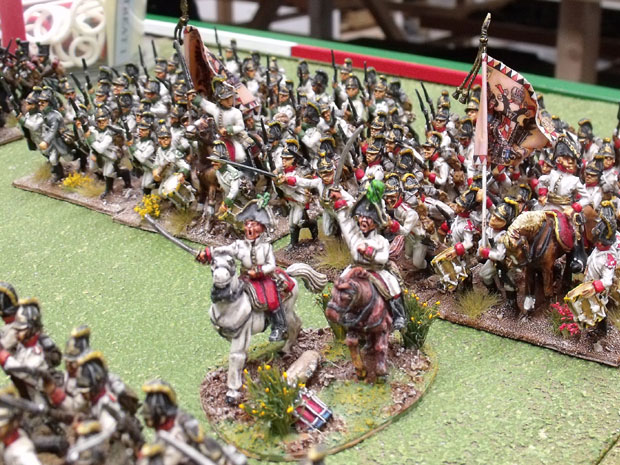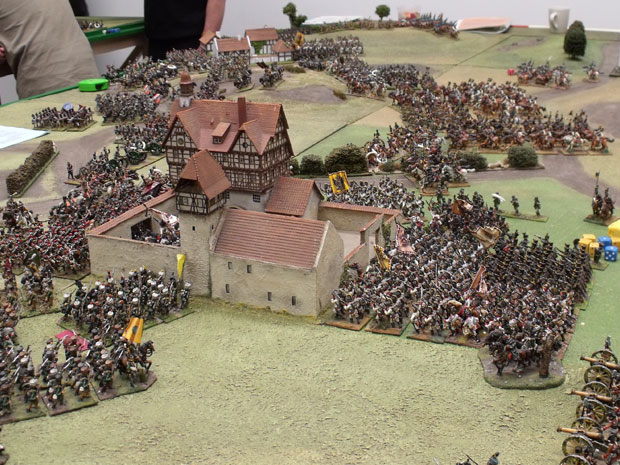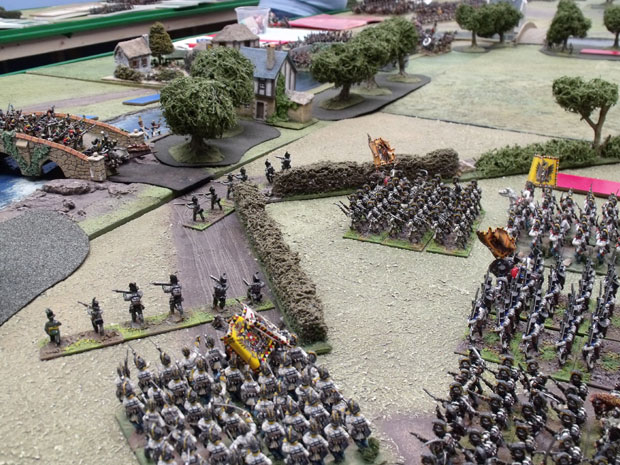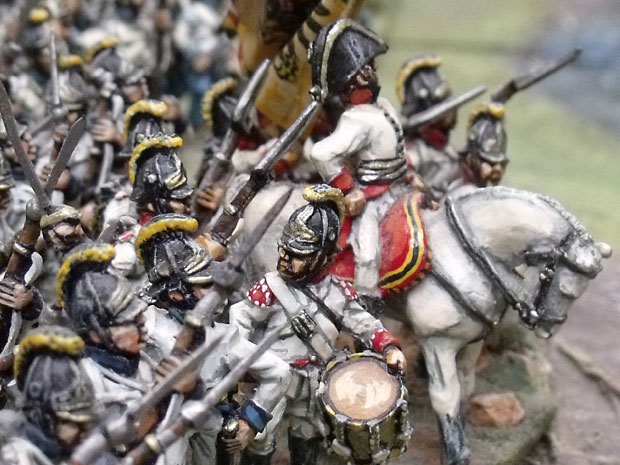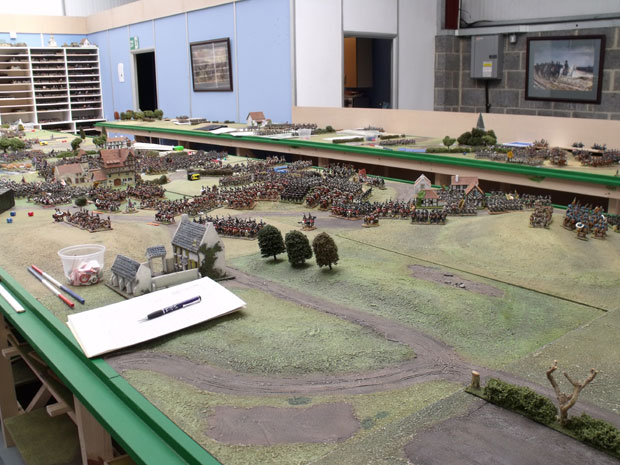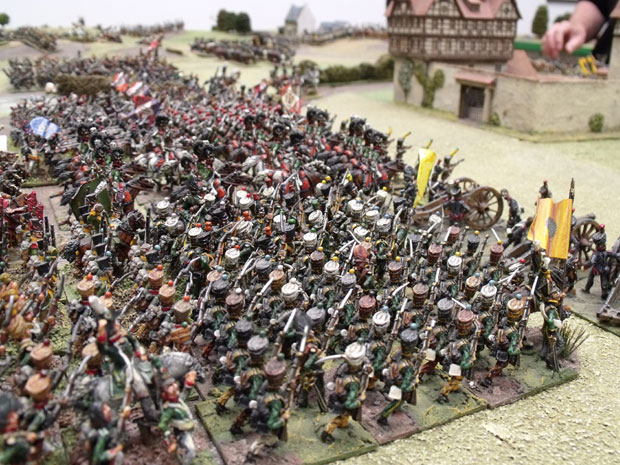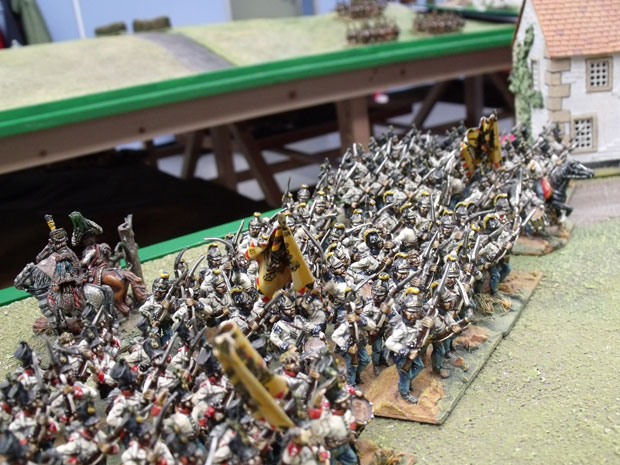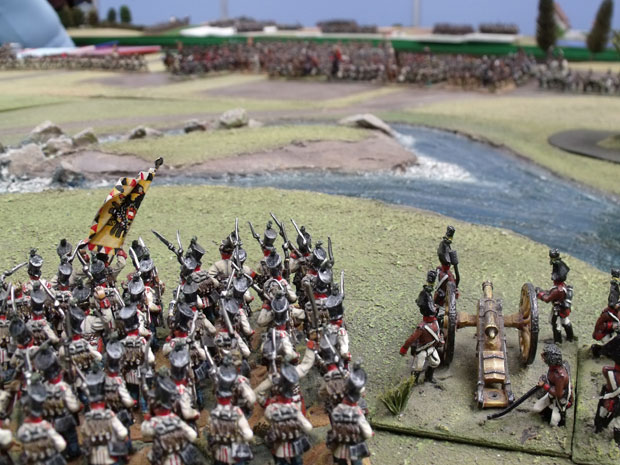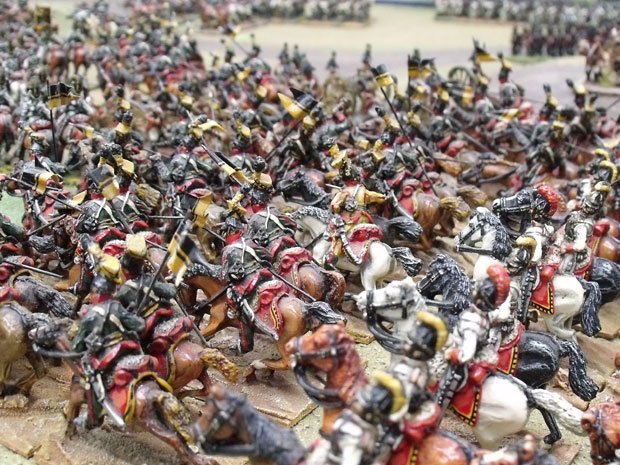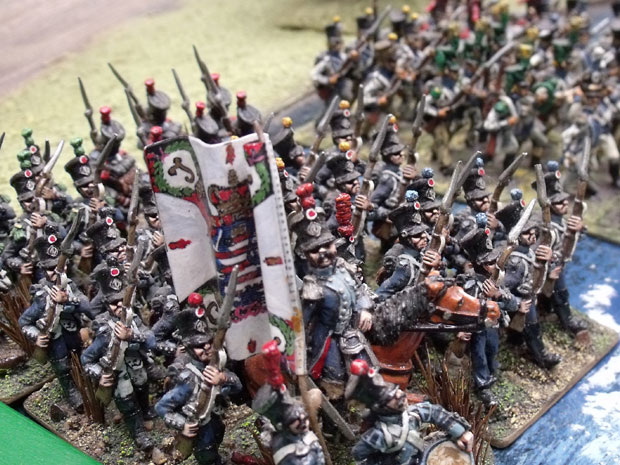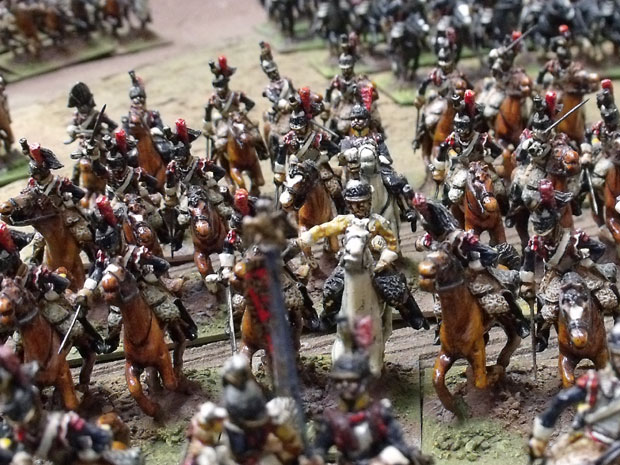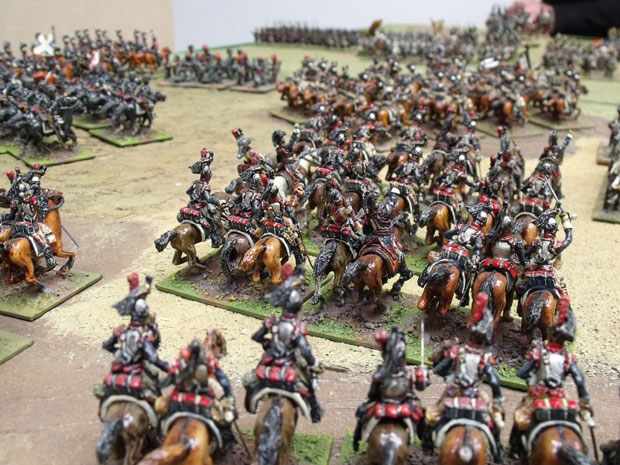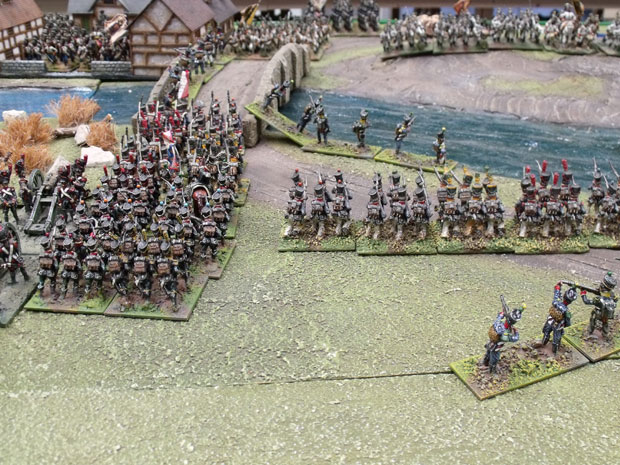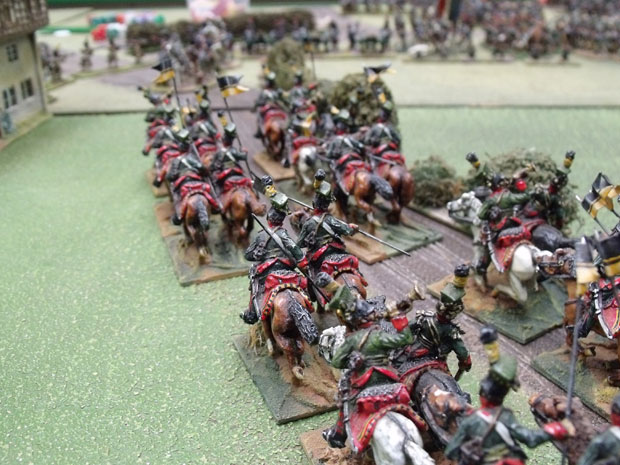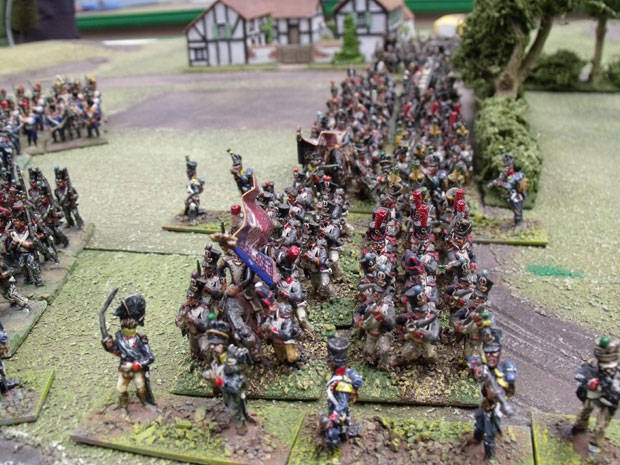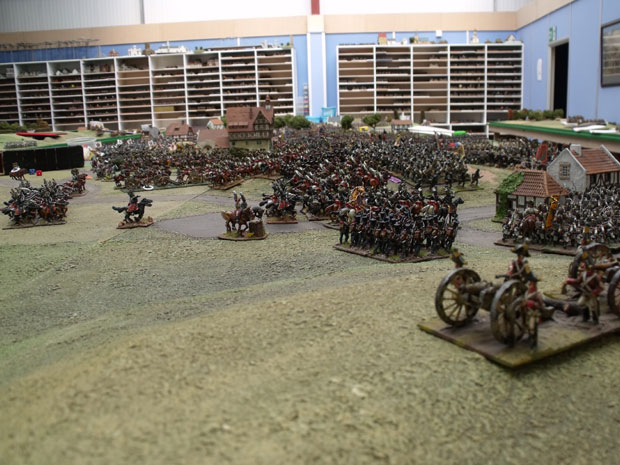The Battle of Bautzen, winning would mean a chance for Napoleon to bring the crown heads of Russia and Prussia to the peace table.
All this needed to be done before Austria entered the war.
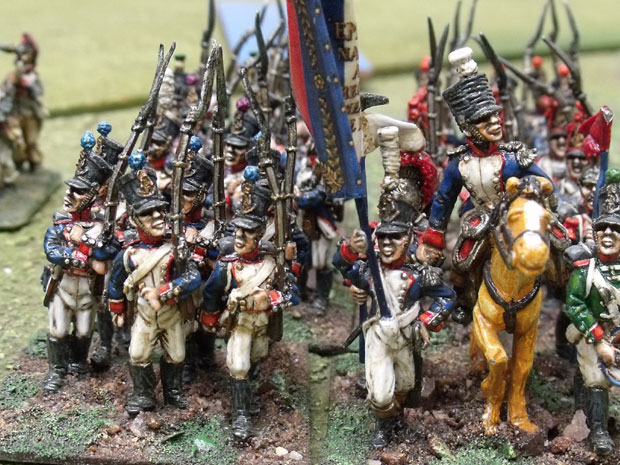
French Line infantry advance to the attack.
Well this weekend promised a real belter, the battle has a lot of redoubts for the Allies, while the French will outnumber them by two to one ultimately. The Corps of Ney, Lauriston and Reynier turn up on the northern side of the map. The French are deployed on the western side of the battlefield while the Allies are deployed along the Kreckwitz heights to the wooded heights of the Dorhmberg.
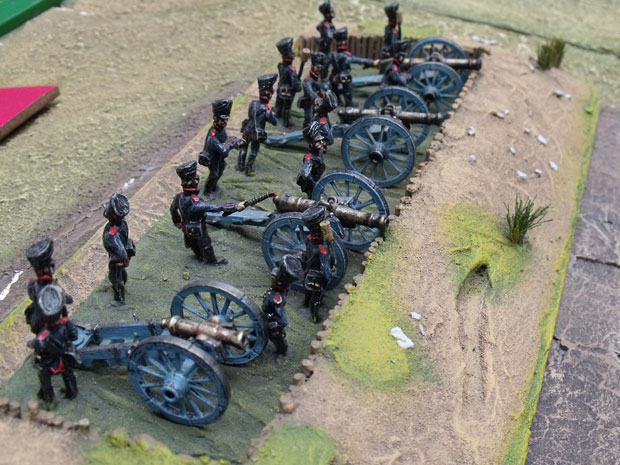
Part of the Prussian defences on the Krekowitz heights.
To begin with the French are allowed to delay the entry of these flanking formations by up to five turns, the fifth turn seeing them appear right at the back of the board as far east as they can gain entry by. As it turned out, Lauriston, came on row three (in the middle of the northern table edge) on turn three and Ney was due on turn five. Reynier was en-route and due around turn eighteen on row four.
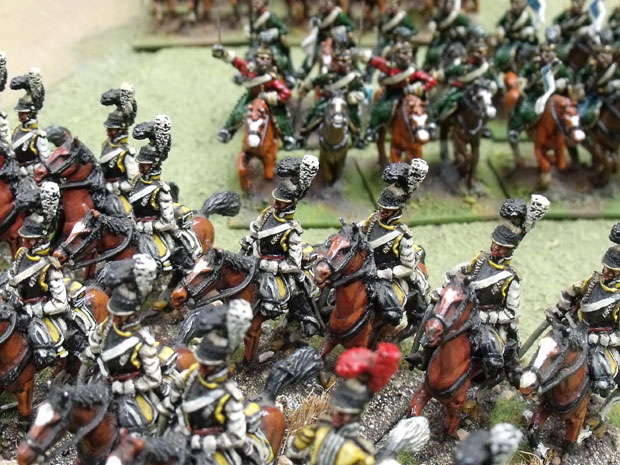
The Saxon Zastrow Cuirassier move to assault the Prussians and Russians on the Krekowitz heights.
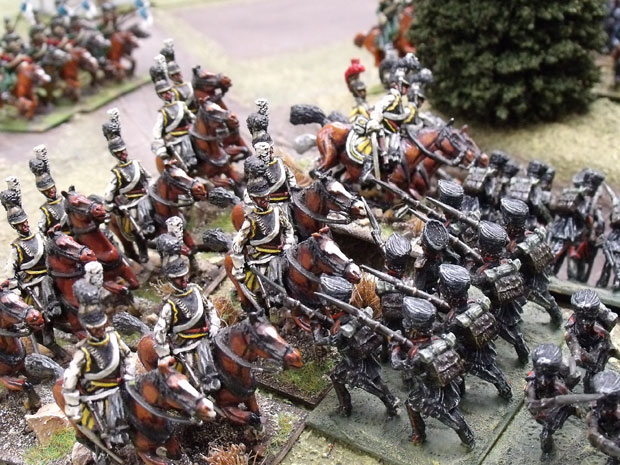
The charge to break the squares on the heights, little success here for the Elite troops of Latour-Maubourg’s heavies.
The deployment of the allies was such that Blucher and his Prussians were deployed to along the Kreckwitz heights and ran from the most northerly area of this due east. The Russian Corps of Barclay, Gortchakov and Miloradovich were drawn up to the south of this, with Constantine to the east of this front line in reserve.

Early Saturday morning, after the first turn, some of the forces still on their tiles.
The opening salvo’s from the French were somewhat limited, the eight pound batteries began bombarding the Allied defences without much effect. After turn two the general advance began, Soult and Bertrand began advancing into the large wooded hill area of the Dorhmberg, formations of the Allies were moving around in the trees but the nature of them was not known as no clear line of sight could be drawn yet. Toward the centre of the French line the Corps of Oudinot began its advance toward the allied redoubts that dotted the Russians positions here in the southern area of the battlefield. Directly behind Oudinot was Marmont and behind that at the furthest point west was the Imperial Guard., north of the river Spree was the Corps of Macdonald, who’s job it would be to link up with Ney and Lauriston as they arrived.
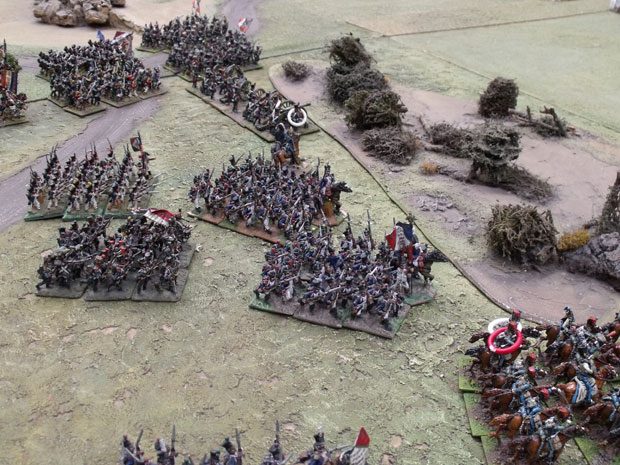
Oudinot’s Corps goes around the marshy ground.
Turn three saw the cavalry of Blucher move out to engage the French Cavalry reserve, the Prussians were backed up by the cavalry of Gortchakov’s Corps, Hussars and Kuirassier. Four regiments of Allied cavalry became embroiled in a fight with up to six regiments of French Lancers and Cuirassier, along with Saxon Cuirassier. The fighting stretched over three turns with regiments of allied cavalry being wiped out and French regiments rallying and charging on!
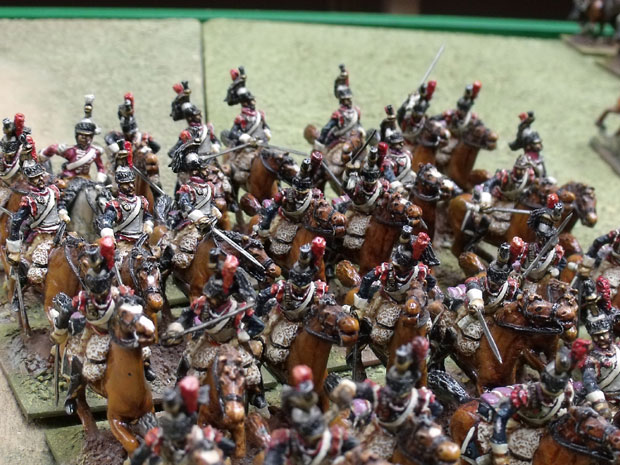
Latour-Maubourg’s cuirassier move out to support the cavalry attacking Blucher.
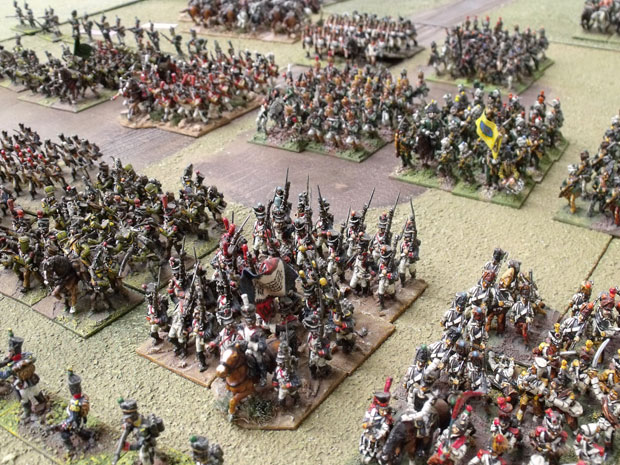
Ney’s leading divisions arrive on the Northern flank.
The punishment for the French troops was great indeed, the twelve pound batteries were split into three gun sections and deployed in redoubts. Each time they fired they were knocking three to five figures off battalions. The battle for the Dorhmberg picked up a pace the French infantry advancing and being swarmed by Sotnia’s of Cossacks emerging from the tree line. Russian dragoons charged the advancing columns but were repulsed, slowly the Corps of Soult and Bertrand gained ground.
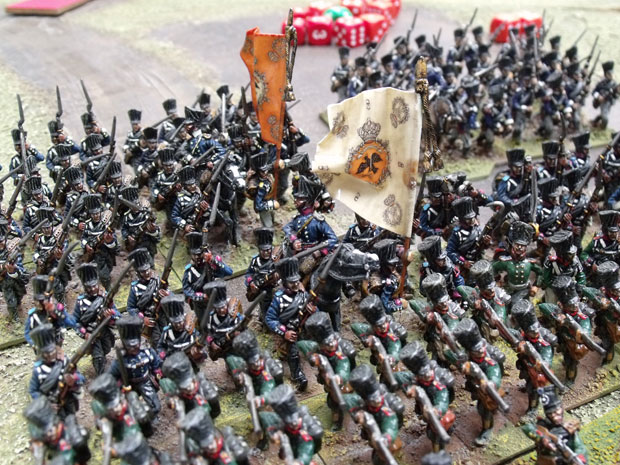
The Prussians from Kleist’s Division look to stop the advance of Lauriston’s troops.
Macdonald advanced across the Spree, the Prussians had a twelve pound foot battery deployed in a redoubt on the most northern section of the Kreckwitz heights and this began to pour destruction on to the troops using the bridges to cross the river.
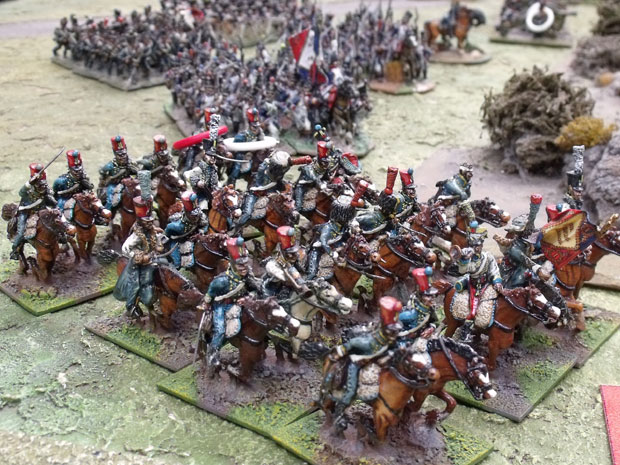
5th Hussars support the advance of the French infantry.
Lauriston arrived on turn three and advanced at speed toward the apex of the line running north and east for the Prussians. It wasn’t long before his lead battalions had engaged in melee with Prussian veterans holding the area just to the North of this apex. The fighting here was fairly intense with the Prussians giving ground initially as the French pushed forward but Prussian reserves turned up in order to push the unformed French back, this then spiralled into some savage fire fights.
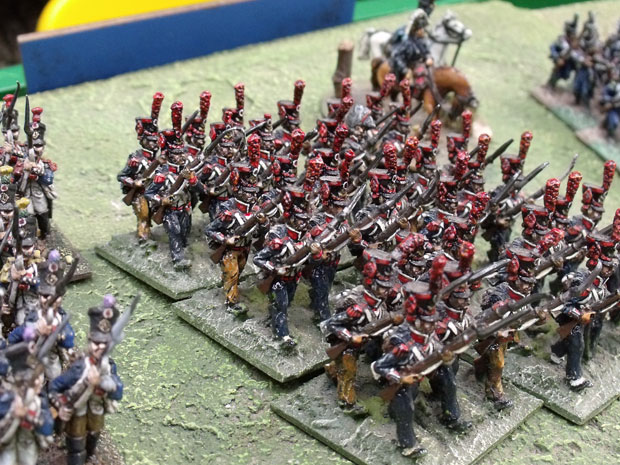
French infantry advance toward the Russians on the Southern flank, these were held up by a regiment of Dragoons for a while before pressing the attack.
To the East the Allied line deployed two of the Prussian batteries on a low long ridge and began to punish the lead elements of Ney’s Corps. The French Dragoon regiment and their Hussars brushed aside the Prussian Brandenburg Hussars, but in doing so became blown and had to retire to regroup.
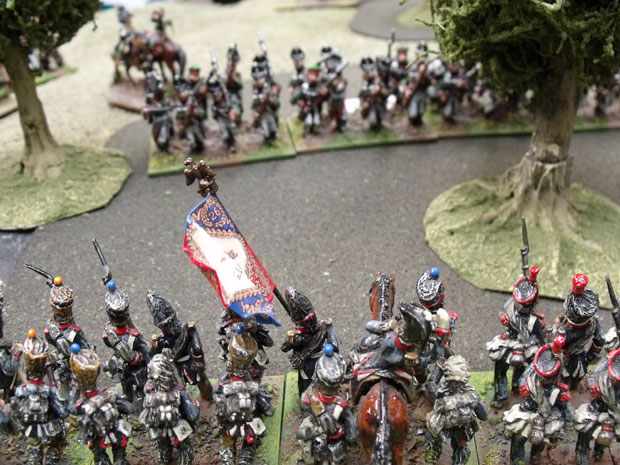
French infantry line out to fire at the defenders in the Dohrmberg.
It was decided at this point to advance with the leading two divisions of Ney’s corps and attack this low hill. A turn after this the lead elements of Constantine’s Guard reserve began to arrive, the Russian Guard Hussars advanced to clear the French skirmisher screen, behind them the Russian Chevalier Guard began to deploy into line, preparing for the assault on the French columns.
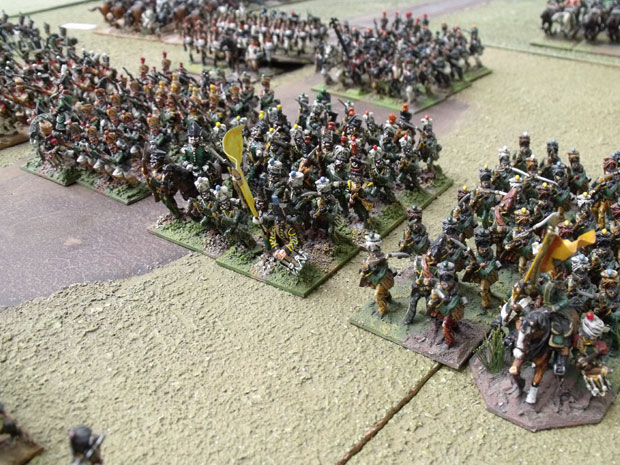
Ney’s troops beat the pas de charge.
Over in the centre, the French columns of Oudinot’s Corps had begun to retreat, the damage wrought by the massed guns from nine twelve pound guns a battery of six pound guns and the Russo German legion’s horse battery was just too much. To make matters worse Miloradovich released his Dragoons on to the fleeing Frenchmen, although if truth were told, they did little other than harass the retiring columns.
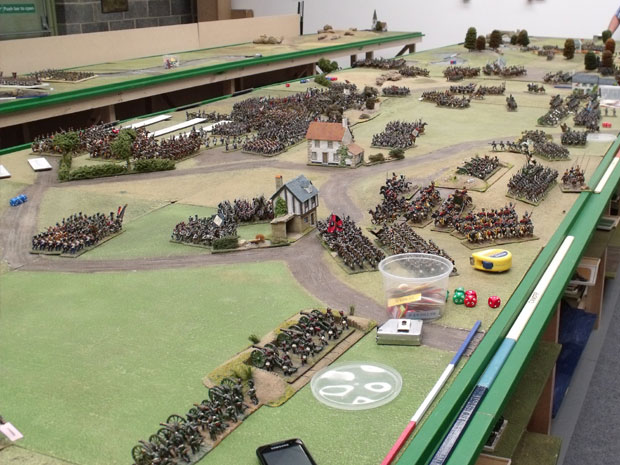
The scene early Sunday morning, before the storm.
Soult was driving the Russians before him on the Dorhmberg heights and the Russians looked to be in trouble, Marmont was forming up for the main assault across the marshy ground into the Russian centre, it was seen that the Russian Guard had now been committed far to the North, so this was a chance to smash their way through.
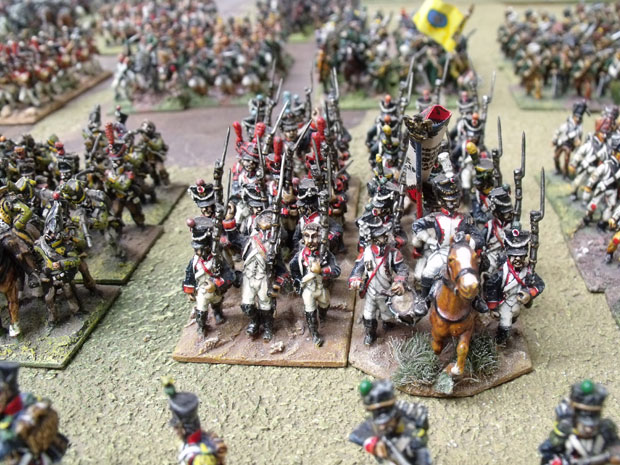
The 46th Line of Ney’s Corps advance into the teeth of the gun line east of Krekowitz heights.
The French Guard began to mobilise around the village of Bautzen.
On the Northern part of the battlefield the Russian Grenadiers moved into position behind the low long hill, behind the Prussian batteries, the Prussian foot battery limbered up and was replaced by the Russian Guard twelve pound battery and all the while the French columns came closer.
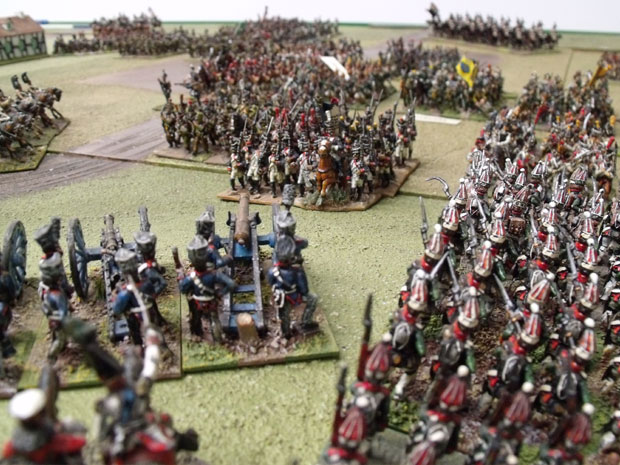
The Russian Guard Kuirassier about to break through the lead division from Ney’s Corps.
The Russian Guard cavalry had stripped away all the French skirmishers from both Lauriston and Ney’s corps at some cost though, the Dragoons had lost some twenty five percent of their operational strength, while the Hussars were retiring to regroup. The Guard Kurassier were the real killers though, emerging from behind a screen of Guard Hussars the first squadron charged a square of French infantry.
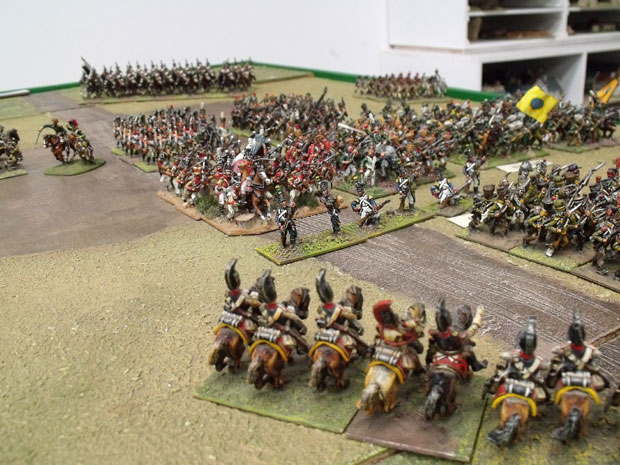
The Russian Guard Kuirassier move toward their targets.
The second and third squadrons charged into the flank of the Division assaulting the low ridge, this also coincided with the Russian Guard Grenadiers emerging from around the back of the low hill and charging the front of the division. In the ensuing melee, eight battalions of French were either cut-down or broke and fled. Still the guns on the hill fired!
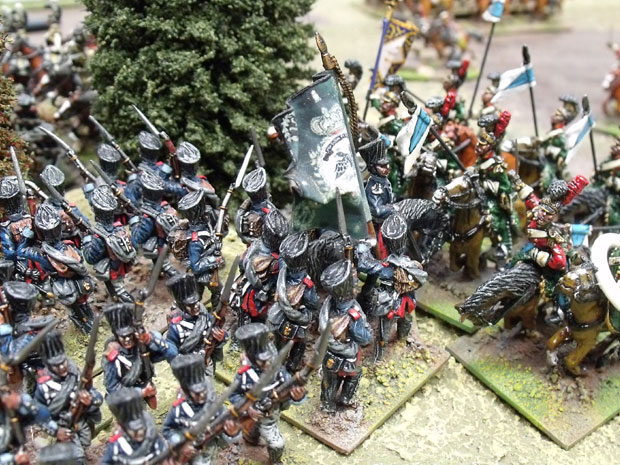
Blucher’s Prussians hold in square on the Krekowitz heights.
Marmont began his advance over the broken ground, casualties falling from the long range shots from the Russian twelve pound guns. The troops from Oudinot’s Corps were streaming back, pinning the troops from the Imperial Guard, Napoleon managed to rally most of these and they then joined the ranks of the Guard to advance again. On came the divisions of Marmont, through shot and shell. Still they came, the French Guard cavalry flanked the Old Guard providing protection from the Russian cavalry that was manoeuvring for a charge opportunity while on the northern flank the light cavalry of Marmont’s division protected this side. The Russian guns piled on the Pressure, opening up with Canister on the troops from Marmont’s force.
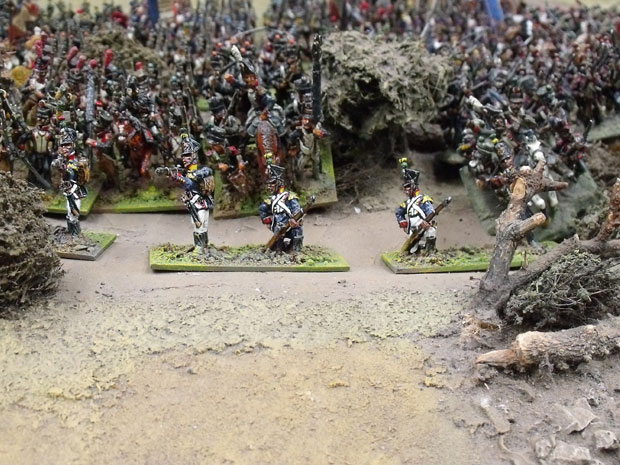
The leading battalions from Marmont’s Corps step into the marshy ground in front of the Russian gun line, the carnage begins.
The Old Guard following one of the Young Guard divisions stepped up the pace, the Young Guard began to die! On the Guard came. There were eight battalions of Russian infantry trying to stop twelve battalions of Elite and Guard infantry! The First Young Guard division swung over to angle a charge away from the Grenadiers and Chasseurs of the Old Guard following them. This would allow the Old Guard space to make their own charge with limited casualties.
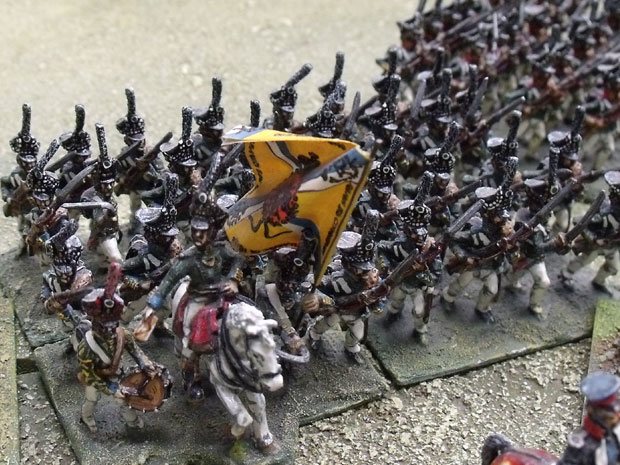
The Russian Guard looking to prevent Ney and Lauriston cutting off the Allied line of retreat if it proved necessary.
Marmont’s Corps hit the Russian lines first, pouring on over the redoubts, putting the gunners to the bayonet, the division of Gortchakov fought back, repulsing the first division.
The Yound Guard followed this by hitting the troops rallying after the melee, their volleys at effective range cutting down great swathes of Russian infantry, the Russians broke!
The old Guard charged the redoubts, butchered the gunners then reformed. The Russians behind the redoubts poured a short range volley into them, but the results were poor. The French Chasseurs a Pied de la Garde spoke, the resulting volley cutting down the first two ranks of the Russian infantry! The Russians held, then charged! The resulting melee was bloody, all eight battalions of Russians were committed! The Guard broke!
The allies held their position and the French would not get another chance! Victory to Wittgenstein and Blucher!


